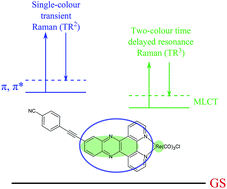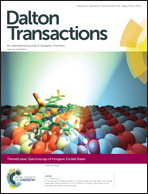Stretching the phenazine MO in dppz: the effect of phenyl and phenyl–ethynyl groups on the photophysics of Re(i) dppz complexes†
Abstract
A series of dipyrido[3,2-a:2′,3′-c]phenazine (dppz)-based ligands have been synthesised in which phenyl or phenyl–ethynyl linkers are terminated by tBu or CN units. The corresponding [ReCl(CO)3(L)] complexes are also prepared. Electrochemistry shows the ligand which contains a phenyl–ethynyl linker and CN substituent is most easily reduced (by 15 mV relative to the other ligands). All complexes are reduced and oxidised at similar potentials. Electronic absorption spectra are consistent with stabilisation of the LUMO by the binding of the metal centre, as complex spectra are red-shifted relative to their ligand. In addition, those containing phenyl–ethynyl linkers show spectra red-shifted (by 650 cm−1) relative to their phenyl-linked analogues. Raman and resonance Raman spectroscopy combined with DFT and TD-DFT calculations are consistent with ligands showing π,π* transitions, and complexes showing metal-to-ligand charge-transfer (MLCT) transitions as the lowest energy absorption. Ligands emit from the π,π* excited state (λem ranging from 450 to 470 nm in CH2Cl2). The complexes show emission from both π,π* and MLCT states; the λem(MLCT) lies at 650–666 nm. Transient lifetimes in CH2Cl2 are decreased by the CN substituent, as this increases knr. Transient resonance Raman spectra (TR2) of ligands show spectral features associated with the LC state, and the strong similarities between these and complex spectra support an LC excited state at 355 nm for the complexes. Two-colour TR3 spectra show only small differences to ground state spectra, the most obvious being a decrease in intensity of C![[triple bond, length as m-dash]](https://www.rsc.org/images/entities/char_e002.gif) C bands. For [ReCl(CO)3(2a)] and [ReCl(CO)3(2b)] an increase in intensity of a 1575 cm−1 band attributed to the dppz˙− species suggests that these complexes have significant MLCT state population between 20–60 ns after photoexcitation.
C bands. For [ReCl(CO)3(2a)] and [ReCl(CO)3(2b)] an increase in intensity of a 1575 cm−1 band attributed to the dppz˙− species suggests that these complexes have significant MLCT state population between 20–60 ns after photoexcitation.

- This article is part of the themed collection: Spectroscopy of Inorganic Excited States

 Please wait while we load your content...
Please wait while we load your content...